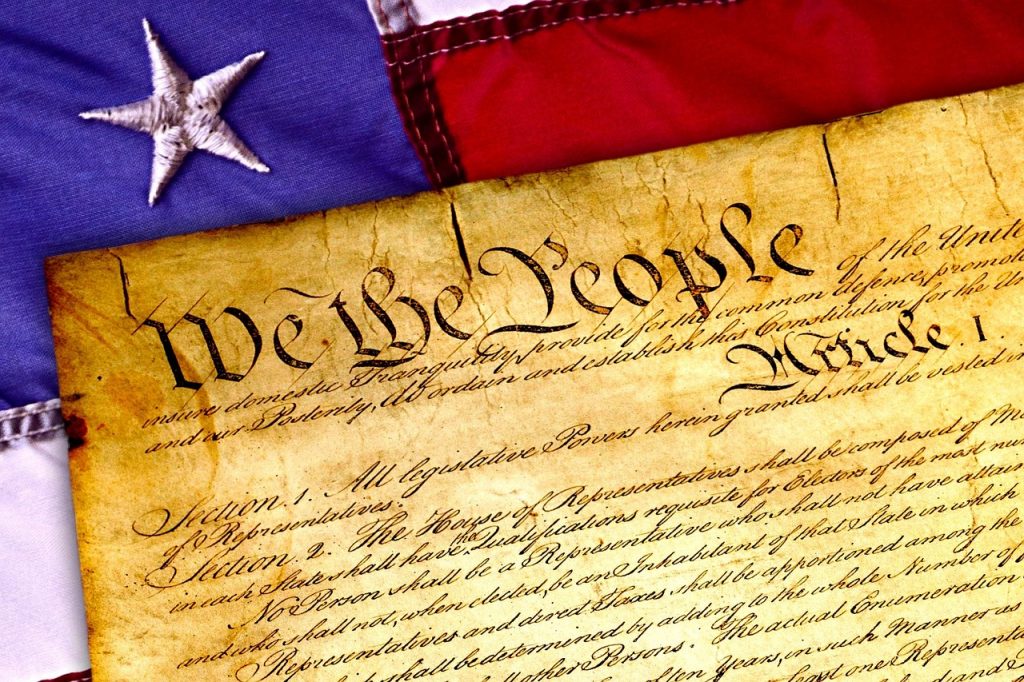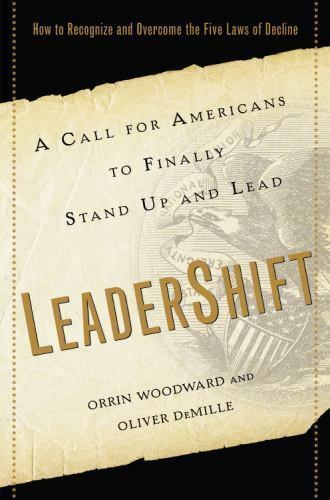News of the Day By Oliver DeMille: Election 2020
August 3rd, 2019 // 12:48 pm @ Oliver DeMille
Election 2020
 Who can challenge Donald Trump in the 2020 election? This question is important — whether you like Trump and plan to vote for him, or don’t like him and plan to vote for the 2020 Democrat nominee, or don’t like him much but feel he’s better than the alternatives.
Who can challenge Donald Trump in the 2020 election? This question is important — whether you like Trump and plan to vote for him, or don’t like him and plan to vote for the 2020 Democrat nominee, or don’t like him much but feel he’s better than the alternatives.
Who can challenge Trump?
Trying to answer this question for myself led to four different lines of thinking, each of them interesting:
Four Options
First, none of the current candidates on the Democrat side seem to possess the ability to effectively inspire broad popular support. One may eventually rise to the top, of course, but it seems it’s going to take a new person with a new charisma, not one of the old names like Biden, Bernie, or Warren. Possible new faces: Kamala Harris? Amy Klobuchar? Andrew Yang? Other? Maybe. But so far none of them have gained any major traction. It’s early, though, so this could change.
Second, one name does strike fear into the hearts of many Trump supporters: Michele Obama. To date she’s strongly denied any interest in running for the Oval Office. But her numbers would likely skyrocket to the top of the ticket if she announced. Will the Obamas refuse this call to power? So far, yes.
Third, perhaps the biggest challenge to Trump in 2020 could come from Jerome Powell. As chairman of the Federal Reserve, he and his colleagues could push interest and inflation rates in directions that would significantly dampen the U.S. economy, throwing a major wrench into Trump’s top accomplishment and the core of his support. This is seldom, if ever, mentioned in the media, but it remains a significant possibility. Stay tuned…and keep watch.
Fourth, a considerable problem for Trump could come from the success of Republican economic policies at the state level. Specifically, no Republican can win the presidency in the current system unless they win both Florida and Texas, but state-level Republican leaders and their pro-growth, low-regulation policies have attracted a lot of businesses and people relocating to these states. The challenge for Trump, and Republicans running for Congress, is that a preponderance of those moving into Florida and Texas vote liberal, not conservative. Trump beat Hillary in Florida in 2016 by just 112,911 votes, and over a million new people have moved to the Sunshine State since then, with over a million more expected by the 2020 election.
The same is true with Texas—Trump won by a more convincing 807,179 votes, but Texas has grown by 1.2 million since 2016 and is projected to grow by a total of approximately 2.3 million by election day 2020 (with about a quarter of these voters moving from California). This significantly changes the makeup of the electorate. Again, more than a mere majority of those relocating to Florida and Texas tend to vote liberal.
Whatever your politics, these four things are worth watching as we move closer to election night 2020.
Interested in more?
 (Oliver DeMille is the author of FreedomShift, which addresses the three key things Americans must to do in the months and years just ahead to effectively protect and keep our freedoms during the growing attack on liberty. Available Here>>)
(Oliver DeMille is the author of FreedomShift, which addresses the three key things Americans must to do in the months and years just ahead to effectively protect and keep our freedoms during the growing attack on liberty. Available Here>>)
Category : Aristocracy &Blog &Citizenship &Community &Constitution &Culture &Current Events &Economics &Featured &Generations &Government &History &Independents &Information Age &Leadership &Liberty &Politics
The News of the Day: Is the Tea Party Movement Over?
August 1st, 2019 // 4:07 pm @ Oliver DeMille
(And Why It Matters)
 Many pundits now argue that the Tea Party movement has stopped being a serious force in U.S. politics since Donald Trump took office. The movement became popular in 2009, garnering a number of significant victories during the 2010 election. It also won some notable elections during 2012 and 2014. It had little power during the 2012 presidential election, mainly because many Tea Partiers considered Mitt Romney a liberal-leaning Republican rather than a genuine fiscal conservative. Major election victories for the Tea Party movement included Rand Paul in Kentucky (2010), Tim Scott in South Carolina (2010), Nikki Haley in South Carolina (2010), Marco Rubio in Florida (2010), Mike Lee in Utah (2010), Scott Walker in Wisconsin (2010 and 2012), Ted Cruz in Texas (2012), Mike Pence in Indiana (2012), Dan Patrick in Texas (2014), and many others.
Many pundits now argue that the Tea Party movement has stopped being a serious force in U.S. politics since Donald Trump took office. The movement became popular in 2009, garnering a number of significant victories during the 2010 election. It also won some notable elections during 2012 and 2014. It had little power during the 2012 presidential election, mainly because many Tea Partiers considered Mitt Romney a liberal-leaning Republican rather than a genuine fiscal conservative. Major election victories for the Tea Party movement included Rand Paul in Kentucky (2010), Tim Scott in South Carolina (2010), Nikki Haley in South Carolina (2010), Marco Rubio in Florida (2010), Mike Lee in Utah (2010), Scott Walker in Wisconsin (2010 and 2012), Ted Cruz in Texas (2012), Mike Pence in Indiana (2012), Dan Patrick in Texas (2014), and many others.
The three major drives of the Tea Party movement were (1) significantly reducing the national debt and deficit, (2) growing the economy by cutting taxes and drastically reducing the levels of federal regulation on the free market, and (3) opposing illegal immigration and its fiscal and national-security dangers. Because candidate Trump gave vocal support to all three of these core Tea Party ideals, many believe the Tea Parties had a major role in electing him in 2016. As mentioned, some suggest that since his inauguration the Tea Party movement has declined and its popularity and influence are now all but extinct. Others argue that by effectively promoting items 2 and 3 (tax cuts and deregulation on a massive scale, and a consistent push against illegal immigration), Trump is implementing the goals of the Tea Party movement from Washington in a way that doesn’t demand continued grassroots protest.
The controversial point hinges on item 1 above, reducing the national debt, or at the very least reversing or significantly slowing its growth. A number of sources have pointed out that on this issue the president hasn’t achieved Tea Party goals, instead increasing the U.S. national debt by well over $2 trillion since he became president. The day Trump took office, the national debt was $19.9 trillion; today it is more than $22.5 trillion. In comparison, during the Obama presidency the national debt rose from $10.6 trillion to $19.9 trillion, by far the largest increase in history. The biggest increasers of the national debt, by percentage, were 1-Franklin Delano Roosevelt, 1048% (of course, he was president for over 12 years, including World War II, but still…); 2-Woodrow Wilson, 727% (World War I); 3-Ronald Reagan, 186% (ramping up and eventually ending the Cold War); 3-George W. Bush, 101%; and Barack Obama, 74%. If Trump follows his projected budgets through 2020, he’ll increase the debt by 30% in his first term; in comparison, Bill Clinton increased it 32%, George H.W. Bush 54%, Jimmy Carter 43%, and Gerald Ford 47%.
Whatever your political views, a 30% increase is far more than candidate Trump promised during the election. His detractors call this a major unfulfilled promise, while his supporters, including many from the orignal Tea Parties, blame it on Ford/Bush/Bush-style RINO Republicans in Congress during 2017 and 2018, and a Democratic majority in the House beginning in 2019. Supporters also argue that a “president Hillary Clinton” would likely have increased the national debt at an even higher rate, without rebuilding the military or rebooting the U.S. economy and improving employment levels like Trump. Regardless of who is correct on these theoretical projections about what “might” have been, it remains a reality that the national debt is still increasing. With the current national debt, every American citizen (and each of their children) owes approximately $69,000 to the national debt. So, if you have a family of four, you owe about $276,000 plus interest and increased government spending going forward. Not a good situation.
If this grows by 30% in the next four years, you’ll owe about $359,000 by mid-2023, in addition to whatever private debts you hold. Increase this every four years by 30%, and we’ve all got a truly massive problem on our hands. Increase it at the Obama rate of 74% and you’ll owe a whopping $480,000 just four years from now. At the George W. Bush rate of 101% your debt in four years will be nearly $555,000. Clearly elections matter (a lot!), and just voting Republican or Democrat won’t help unless the candidate is actually a fiscal conservative; just look at Bush’s 101% rate of national debt increase! Even Obama did better. This is why the Tea Parties were just as frustrated with Bush and others they called RINOs as with Obama. Moreover, since many in the bottom tax brackets won’t pay their share of this, or any of it, and the upper class is adept at finding loopholes, most in the middle class will likely be charged double or even triple their share. By such Beltway math, in four years at Trump rates you’ll owe $1,076,400 to the national debt, or in Obama rates you’ll owe $1,440,720. If you have more than 2 kids, increase what you’ll owe accordingly.
All this to say: Given the numbers, I don’t buy it when the pundits claim the Tea Party movement is over. Right now Tea Party types are alarmed that the debt is growing at a relentless clip of 30%, but happy that it isn’t continuing at Bush or Obama speed; 74%-101% is a back breaker for everyone. Most of these people are relieved that Trump brought it down so far, so quickly, But if the rate ever climbs much higher than 30%, we’ll see major tax increases, significant unemployment numbers, and a much tougher economy. This will spark the return of millions of Americans demanding better fiscal leadership—no matter who the president is, no matter what party he/she represents. It might be called the Tea Party, or it might adopt some other nickname, but 30% debt growth is already a major long-term disaster, and a higher rate will be…too much. Increase it a little, or a lot (as many current politician’s proposals will guarantee), and we’re going to see the rise of major political reform groups that stand up and make their voices felt—loudly. If Trump continues to bring down the debt rate in significant ways, they’ll likely hold their tongues. If it goes the other direction, the next round of conservative/libertarian populist demonstrations will probably make the 2009-2016 Tea Party revolution look mild in comparison.
And, for the record, note that Europe is on the same path. Unless Western democracies get serious about addressing their massive debt/entitlement problem, the political upheaval and angry divisions of the Tea-Party/Occupy/Trump/Brexit era are going to surprise us only by how mild they were.
Sources:
- TheBalance.com (statistics on national debt dollar amounts and rates per president)
- Worldometers.info (statistics on population)
- U.S.DebtClock.org (current national debt and growth pattern)
- Wikipedia (election victories by Tea Party candidates)
- Britannica.com (historical details and statistics on Tea Party movement)
Category : Blog &Citizenship &Constitution &Culture &Current Events &Economics &Featured &Generations &Government &History &Independents &Information Age &Leadership &Liberty &Politics
The News of the Day
August 1st, 2019 // 4:03 pm @ Oliver DeMille
The Mueller Hearing
 Two big things do stand out. First, Mueller was asked a number of questions about the report but frequently didn’t know what the report said. Even when Congressmen read quotes from the report, Mueller repeatedly couldn’t remember names or details. He seemed to not know much of what was written in his own report. Strange. To give someone so much power—literal power over the lives of real Americans—but who seems feebly unaware of what his own report says or even the names and details written in his report, is scary. Also, to the chagrin of many on the Left, it came out that Natalia Veselnitskaya, the Russian lawyer who famously met with Don Jr. in Trump Tower to share “dirt” on the Hillary campaign, actually met more times and much longer with the Hillary campaign to communicate “dirt” on Trump—making everything critics have claimed about the “inappropriate” Trump Tower meeting much worse for Hillary than for Trump.
Two big things do stand out. First, Mueller was asked a number of questions about the report but frequently didn’t know what the report said. Even when Congressmen read quotes from the report, Mueller repeatedly couldn’t remember names or details. He seemed to not know much of what was written in his own report. Strange. To give someone so much power—literal power over the lives of real Americans—but who seems feebly unaware of what his own report says or even the names and details written in his report, is scary. Also, to the chagrin of many on the Left, it came out that Natalia Veselnitskaya, the Russian lawyer who famously met with Don Jr. in Trump Tower to share “dirt” on the Hillary campaign, actually met more times and much longer with the Hillary campaign to communicate “dirt” on Trump—making everything critics have claimed about the “inappropriate” Trump Tower meeting much worse for Hillary than for Trump.
Second, and this is a big deal, the Mueller Report, and Mueller’s testimony in the hearings, states that the Special Counsel didn’t “totally exonerate” the accused. This is a whole new approach to American law. Prosecutors in the United States have never had the authority or power to “exonerate” anyone. They can charge, or not charge, a person. But they don’t exonerate, or withhold exoneration. This is at the heart of the freedom that the accused is presumed innocent until proven guilty. If we live in a nation where a citizen must receive “exoneration” from a government prosecutor or be presumed guilty, or receive “total exoneration” from a prosecutor or be presumed partially guilty, we’ve lost a major part of American freedom. Indeed, this was the most important difference between Anglo-Saxon law and European Norman law in history—and the American Framers loudly rejected the Norman approach and established “innocent until proven guilty” as the bedrock of American law. When asked about this Mueller doubled down that the prosecutor can decide whether to exonerate or not exonerate an accused American, a return, at least in his mind, to the historical Norman approach of Dictatorial law.
No prosecutor in U.S. history has had, or claimed to have, this power until now. This is a serious and dangerous example of “creep” by government usurping powers that are not part of the Constitution. Unless Americans refuse to let this stand, another major freedom will be lost. This campaign is already underway. For example, the lead headline for the hearings by CBS was: “Mueller: President Trump was not totally exonerated in Russia probe…” In response: First, he was in fact entirely cleared of Russian collusion charge. The not “totally exonerated” language was applied only to the issue of “obstruction of justice”. CBS absolutely lied in printing the headline this way. Second, no prosecutor in U.S. history has ever had the power to proclaim an accused American “not totally exonerated”; nor does any prosecutor in the U.S. have that power today; nor does Robert Mueller have that power. But the media pretended, and reported, that he does. Another lie. A very dangerous one. A number of other media outlets issued similar misleading headlines during and after the hearings (see, specifically, NBC, ABC, CNN, HuffPost, NPR, BBC).
If Americans let this view stand, I predict we’ll see every future U.S. President, from both political parties, who faces an opposing party in the House, attacked by such hearings and special investigations and be labeled “not totally exonerated”. Likewise, and worse, we’ll see this Mueller precedent abused by numerous prosecutors around the nation who use “not exonerated” as a new power against American citizens, and “innocent until proven guilty” will decline as a basic freedom. Any prosecutor who claims “we didn’t exonerate” an accused person is directly rejecting the system of “innocent until proven guilty” and replacing it with “guilty unless a prosecutor exonerates you”. This moves us back toward the Norman dictators, away from the Anglo-Saxon and American Founding systems of law. Any prosecutor who does this is directly attacking the U.S. Constitution. This includes Robert Mueller. On a personal note, I haven’t been this sickened by the actions of a national government official since the George W. Bush Administration used the Justice Department to investigate political opponents for the specific purpose of influencing the election, or since Eric Holder covered up Fast and Furious. All three are examples of glaring government corruption. Add the Benghazi scandal to this same disgusting list.
In the weeks ahead, many Democrats, and many in the left-leaning mainstream media, will likely repeat the storyline that Mueller “has given us evidence of Trump obstruction”, and the Right will continue to say the exact opposite. The words of the Constitution should be the way we clearly understand this. Did the president engage in “treason, bribery, or high crimes and misdemeanors” with regard to Russia in the 2016 election? Meuller said no, in both his Report and the hearings. Did the president engage in “treason, bribery, or high crimes and misdemeanors” in regard to obstructing justice? Mueller said in the Report that there was not “sufficient” evidence to charge the president for this, but he said in the hearing that if a regular citizen, not a president, had been the target of the investigation, he would have seen sufficient evidence to charge. He later also joked that he probably wouldn’t have found “sufficient” evidence if the target was a member of Congress. This jest, and the way the crowd of Congressmen reacted to it, reinforces the shocking double standard at play in all this. Government officials are to be treated differently than regular citizens, by this standard. What does the actual law say about this? Most attorneys and judges on the Right say no, there was not sufficient evidence to charge a regular citizen, and most on the Left say yes–at least those cited in the media. This is political posturing, pure and simple.
Compare this to the Bill Clinton investigation. The Independent Counsel indicted Clinton on 11 specific counts. Special Counsel Mueller’s report says they didn’t have sufficient evidence to charge Trump on even 1 count, or to recommend to the Attorney General a charge on even 1 count. Let’s just apply the Constitution. If a majority of the House believes the president has committed “treason, bribery, or other high crimes and misdemeanors”, they should impeach him. And then the Senate can judge and make the final decision—impeaching by a two-thirds majority if it so chooses. Then the citizens can analyze what each Congressman and Senator voted on this, and respond to it in the next election. That’s the Constitutional way to handle it. The problem is that the media is trying hard to sway popular opinion in this, instead of simply reporting the facts. But that’s okay. The American people are smart enough to see through media bias in reporting. It’s so blatant now that almost everyone notices.
The big danger, something few Americans do realize, is that we now have the basis for a new precedent, a legal approach that some prosecutors will almost certainly claim as precedent in the future (and that some judges will inevitably allow), that an accused American can be presumed guilty “in certain circumstances” unless he/she is “totally exonerated” by the prosecutor. Such a reversal of “innocent until proven guilty” to an alternative standard of “guilty unless declared ‘totally exonerated’ by the prosecutor” is a disaster for freedom. Most people won’t even realize it’s a thing for many years to come unless it is used directly against them in court. But if it is ever used in America, even once, it is a massive attack on freedom. It will likely be applied quietly and behind closed doors many times, if it follows the normal pattern such precedent take in our history. This is precisely how past major reversals of our freedoms have gained traction in the judicial branch, one case and one courtroom at a time. For example, this is how precedent became a “higher law” of the land and gave the Court unconstitutional power over all law instead of just authority in one specific case at a time, how people serving on juries largely lost their official power to nullify bad laws in a specific case, and how trial by jury became trial by people who don’t know the accused rather than trial only by people who knew the accused (the legal term is “jury of the vicinage”). All of these changes are now the norm, and most people think they always have been the American way. But they are in fact major losses of our freedoms, drastic departures from the intent of the Founding Fathers and the Constitution. Few people even know about them, mostly because all of them were lost the same way “innocent until proven guilty” is now being undermined—quietly, in the fine print of distant courts. But the loss of freedom is drastic and real. The Mueller Report, the strongest attack on “innocent until proven guilty” in American history, marks a very bad day for America, and for our freedom.
Category : Blog &Citizenship &Community &Constitution &Current Events &Generations &Government &History &Information Age &Leadership &Liberty &Politics
News of the Day – Media Spin
July 25th, 2019 // 3:37 pm @ Oliver DeMille

I. Today in the News
There is so much going on in the news these days–big events that have major potential to influence the future of our nation and freedom. Unfortunately, almost all the news is reported with strong partisan leanings. The slant and spin are frequently overwhelming.
To respond, I’ve decided to do an in-the-news series that steps away from current partisan spin and addresses the big news of the day from the perspective of the U.S. Constitution and the viewpoint of the American Founding. It will give readers a different way to look at things. I’ll try to keep these brief and to the point, just a few paragraphs per post. I hope you will comment and share so this can influence people…
II. July 2019: Media Spin
Most people tend to see modern media as two groups warring with each other—the media Left versus media Right—over what’s really going on in America. Whatever politicians do in Washington, the Left media spins it one way, and the Right media either spins it differently or seeks to debunk what the Left media has reported. Most Americans tend to see through this spin, but very few see the “other” part of what’s actually happening.
We live in the age of reality entertainment. Sports, the original reality show, is very popular—especially big events (like the Super Bowl) on live TV. Live politics, such as debates, are popular as well, though not quite as popular as sports. Reality television programs continue to garner and keep avid fans every season.
Perhaps if we really thought about it, we would realize that there is a formula of success for reality television. Extra credit if you realize that it applies to politics every bit as much as it does to shows like The Bachelor, the Super Bowl, Survivor, Keeping Up with the Kardashians, American Idol (and all it’s talent and dance spin-offs), March Madness and the NBA Playoffs, the Real Wives series, The Apprentice, etc.
Survivor – Media Style

Here are the key points in the formula of Reality-TV Success:
- Ratings depend on a battle between two sides
- How strongly people hate one or both of the sides drives ratings, the more intense the hate, the higher the ratings
- To get non-interested people to start watching the show, you need to get regular people talking about the villains they hate on the show (so the uninterested people will hear about the controversy in strong enough terms that a number of them tune in)
- The battle and controversy must escalate each week, to keep people watching
- Viewers must know that a major showdown (a finale) is coming, and that it will portray high drama with a clear winner who takes all the spoils and a loser who is sent home with nothing [in politics, this finale is the next major election]
- Only hated villains increase ratings drastically, so the job of producers and reality-show participants is to exaggerate and dramatize the conflict, over and over, the more the better
- If you want to win, you need to be seen as strong and trying hard but also vulnerable, you need to be attacked and hurt, “bloodied” by your enemies and opponents, but refusing to give in or give up, to the point that many viewers are rooting for you (as much as they are simultaneously wanting the villains to lose, and as much as half the viewers are hating you and seeing you as the villain)
- If you are portrayed as a villain on such a show, the key is to find an even bigger villain, show how they’re hurting you, and create a major conflict between you and them
- Only outlandish, extreme behavior reaches a lot of new viewers and thus boosts ratings, and such behavior must be repeated next week if you want even more new viewers
- Being liked and considered good and classy kills ratings and viewers tune out, only tuning back in when there are bizarre and extreme attacks and controversies [in sports this is often achieved by bad behavior off the field and also by strong team rivalries and hatreds; the same is true for many actors and celebrities whose careers are in decline and they need to find a way back into the news]
- Only when you are strongly attacked will people really listen to you or care about you, and when you fight back effectively (i.e. in extreme ways) you will be admired by some and gain new support
- What happens on screen must be interesting enough that other TV shows and social media posts are inundated by people attacking you, and others defending you, or you aren’t going to win
- The more extreme attackers you can get to “gang up” on you, the more your supporters will line up to vocally defend you, and the more supporters you’ll get over time.
This formula can be weakened a bit by judges on shows where such judges have real power; but on TV shows where the viewers are the only judge, these rules become even stronger.
Now apply all this to politics, which is currently covered by the news media and posts on social media using these same reality-show rules. Add to this the tactic of “baiting”, where one contestant wants to gain more supporters, so he/she attacks another person or group in an extreme way, in order to hopefully elicit an extreme reaction, which will in turn get a lot more supporters for himself/herself.
One reason this tactic is so effective is mentioned above: extreme controversy gets uninterested people to pay attention and take sides, and some of them will join your side.
But wait…some will join the other side too, so how does this actually help you?
Answer: When some new viewers join the other side, and some join your side, you don’t gain much. But when you bait multiple people and groups, incentivizing some to join you and others to join those you attack, you gain support with every controversy, but those joining your enemies typically join ONE person or group you attacked, while not emotionally joining the entire other SIDE.
Specifically, for example, when president Trump baits Nancy Pelosi and then later baits Alexandria Ocasio-Cortez, and then later Joe Biden, and Bernie Sanders, and then CNN, etc., he gains more supporters every time–depending on the level of controversy and intensity of attacks by him and against him. But while each controversy also gains supporters for each of the attacking entities, they aren’t united. Indeed, many who take Pelosi’s side really dislike Alexandria Ocasio-Cortez, and vice versa. Many who take Joe Biden’s side don’t like Bernie Sanders, and vice versa.
In fact, these smaller factions often try to tear down each other as much or even more than they try to denigrate the president. But ALL the new supporters gained by the president in each separate controversy give more to support him. At the same time, this pattern creates the feeling that everyone is ganging up on the president, engendering more sympathy, stronger emotions of support by his base, and more new supporters who dislike that he’s being ganged up on and also new supporters who like the way he stands up, all alone, to the gang that is piling on against him.
See the Whole Board

This is the same formula utilized in most popular high-action movies, viz. Chuck Norris, John Wayne, The Rock, Rocky and Rambo, Arnold Schwarzenegger, Mission Impossible, Bruce Willis, Captains Kirk and Picard, Black Panther, Wonder Woman, James Bond, The Matrix, the Flash, Jason Bourne, Avengers, etc. It’s the same pattern outlined in steps 1-13 above. Superheroes and superheroines stand against all odds, despite personal struggles or individual character flaws, and battle for what they believe in, suffer attacks and are hurt, and keeping fighting anyway, until they eventually win over evil.
Indeed their personal weaknesses, shortcomings, mistakes or character flaws almost always endear them to their supporters, because the “heroes” stand up against the attacking enemies even though they themselves are flawed and far from perfect. Think Iron Man, Sherlock Holmes, or Bruce Wayne.
Ronald Reagan was great at creating this heroic “reality” in the public mind, so was president Obama. JFK impressively did it before “reality shows” were even a thing. Bob Dole and Michael Dukakis were terrible at it, as was John Kerry. Kissinger was good at it, and Al Gore understood it and tried to do it, but couldn’t quite pull it off.
Neither George Bush was very good at it either, nor was Jimmy Carter. Marco Rubio and Bernie Sanders didn’t do it well; Chris Christie is great at it, but not quite as good as Trump. Bill Clinton mastered it, but Hillary struggled—just didn’t quite get it, mainly because she wanted to “be liked” too much.
This appears to be the same reason Jeb Bush, John McCain, and Mitt Romney couldn’t use it very well—the extreme attack, the relentless controversy, the bizarre media battles, and purposely getting half the nation to hate you so the other half would support you, just wasn’t their thing. They wanted everyone to like them. Donald Trump is more interested in winning than being liked, and he is even better at reality-show tactics than Bill Clinton.
Joe Biden tries, but so far isn’t very good at it. But the real issue is whether the American people understand these tactics and recognize when they are being employed. Those who dislike Trump consider such reality-TV tactics lacking in taste, class, and decency, but tend to admire the same tactics when launched by those from their side of the aisle. Trump supporters who understand this tactic generally wink and laugh when the president so effectively employs it against the Left, but they frown when it is used by Nadler, Schiff, Pelosi, Rachel Maddow, Chris Matthews, Stephen Colbert, Robert De Niro, or Alexandria Ocasio-Cortez, among others.
One way to quickly recognize this tactical approach is simple: Whatever tonight’s mainstream news is openly attacking about Donald Trump, go see how he baited it. See what person or group he’s baited, and how the news media is sucked into spreading his plan for their response of “zealous, extreme outrage” far and wide.
The more angry and adamant the news reports, the more effective his tactic. One little group of his opposition grows, but his support grows even more, bit by bit over time. Then watch his approval ratings a week later–both among his base, and overall. The ratings almost always increase a bit after a major controversy where he baits someone and then the mainstream media attacks him.
The more extreme the attack, the more he usually benefits. An important longterm question is: can Alexandria Ocasio-Cortez master these same reality-show tactics? (Think 2020, 2022, and 2024 House and Senate elections; and the 2028 presidential race.) So far, she’s rivaled Trump in this reality-TV-style tactical arena. Some might argue that she’s even better at it.
As for 2020, a salient question is whether Kamala Harris or Elizabeth Warren (or any other candidate) can dominate reality-show tactics more effectively than Trump? Though the election cycle is just beginning, Kamala so far seems very adept with these tactics. Measuring effectiveness according to these tactics, Kamala is right now the clear frontrunner for the Democratic nomination in 2020.
Think Several Moves Ahead

Finally, why do such tactics work? The answer is deeply rooted in human history, perhaps even in our ancestral/emotional DNA. Stories are our deepest language, and stories of the the underdog battling for what’s right, against evil, protecting the little guy against the “dark” forces of might and massive power, especially against all the odds, while being attacked from all sides, are ingrained in our collective experience.
The Left tries to use this same plotline against Trump (the plight of illegal immigrants), while the Right turns it against his opponents (the rising sinister forces of socialism). Each time the president baits anyone on the Left, or even the Right, the mainstream media’s response is so extreme, so howlingly mimicking the voices of an angry mob, that they make him look like the besieged warrior standing alone, refusing to stop believing or fighting for what he thinks is right.
In any plotline from reality TV or movies (or literature), the figure cast in such a role is always the hero. Regardless of the words spoken by the “sides,” year after year, with each night’s news, this narrative remains firm. And it grows each time it is broadcast, reinforced with every new and different situation.
In 2016 Trump inhabited this image, this feeling, more effectively than anyone else. In 2020? We’ll see. But so far the mainstream media is absolutely addicted to repeating this narrative every day, every evening, every newscast. And the president makes sure they keep doing it. It might possibly be that only someone who does it better, whatever their politics, can displace him.
The real issue, as mentioned, is whether or not we as citizens understand this—when it is utilized by Trump, Alexandria Ocasio-Cortez, Bernie Sanders, Kamala Harris, or anyone else on the Left or Right.
It is our job to oversee and guide our nation’s future. We can only do this if we are playing chess, not checkers—clearly seeing through spin from all sides and immediately/consistently recognizing what is bait and what imagery is portrayed in every controversy.
Those playing “checkers” will hear the roar of the mainstream media criticizing a political figure and belief that he/she is on the ropes; those who actually understand what is happening clearly know that such noise communicates the exact opposite.
Category : Blog &Citizenship &Culture &Current Events &Featured &Generations &Government &History &Independents &Information Age &Leadership &Liberty &Politics &Statesmanship &Technology
THE JEFFERSON-MADISON DEBATES: Can the Constitution Survive?
July 17th, 2019 // 8:20 am @ Oliver DeMille
PART I
 European “Conservatism” and American “Conservatism” are not the same thing.[i] It’s important to realize that “conservatism,” in the generic, isn’t defined as a specific platform or set of ideals. It’s simply the posture and priority of “conserving” a certain tradition or form, as opposed to “liberal–ly“ or “progressive-ly” moving away from said tradition or form.
European “Conservatism” and American “Conservatism” are not the same thing.[i] It’s important to realize that “conservatism,” in the generic, isn’t defined as a specific platform or set of ideals. It’s simply the posture and priority of “conserving” a certain tradition or form, as opposed to “liberal–ly“ or “progressive-ly” moving away from said tradition or form.
As George Will has pointed out, in Europe “Conservatism” was rooted in protecting monarchy, aristocracy, and the class system (where the many are ruled by the few), while in America “Conservatism” means protecting and maintaining the U.S. Constitution and the principles upon which it was framed, including the key principles articulated in the Declaration of Independence.[ii] Indeed the Declaration itself initiated the end of European Conservatism in America.[iii]
The tug-of-war between American Conservatism and Progressivism has been part of the American story ever since.[iv] Progressivism has gone through several stages–all of them a direct and escalating attack on the Constitution:
Step 1- Statism: Increase the size and scope of the government
Step 2- Centralized Statism: Increase the size and scope of the federal government
Step 3- Liberalism: Use the increasing size and scope of the federal government to redistribute money from the affluent to the lower classes by state force
Step 4- Socialism: Use the increasing size and scope of the federal government to redistribute money from the affluent and middle classes to the lower classes by state force, putting control of the federal government in the hands of a few, and also mandate social and environmental causes that require the federal government to grow even more
Step 5- Globalized Socialism: Expand progressive goals to include federal government programs for people around the globe (not limited to American citizens), requiring a massive expansion of government size and scope and progressive transfers of power and sovereignty from the American voters (and voters within other nations) to international organizations, agreements, and entities
We are currently in the High-Growth Phase of Step 4 and the Early-Growth Phase of Step 5.
PART II

American Conservatism, in contrast, focuses on implementing the U.S. Constitution, a return to Constitutional limited government (to the extent that we’ve moved away from the Constitution), and a citizenry that rules itself rather than being ruled by a class of elites.[v] Today the battle between Conservatism and Progressivism is in full swing.
To measure which side is ahead in this contest, the scoreboard is a simple two-question matrix:
- Is the size, scope, debt, and expenditure of the federal government shrinking?
If “Yes,” Conservatism is winning.
- Is the size, scope, debt, and expenditure of the federal government expanding?
If “Yes,” Progressivism is winning.
This is the only real indicator of direction, momentum, and victory. Every other possible marker can be faked or obscured. What this scoreboard shows is that the following administrations in the modern era have increased American Progressivism (thus decreasing Conservatism/Adherence to the U.S. Constitution):
- Roosevelt
- Truman
- Eisenhower
- Kennedy
- Johnson
- Nixon
- Ford
- Carter
- Reagan
- Bush
- Clinton
- Bush
- Obama
- Trump
In contrast, the following administrations reduced the scope, size and expenditure of the Federal Government, increasing American Conservatism and adherence to the U.S. Constitution:
NONE
This comes as a surprise to many conservatives. Indeed, this reality makes it clear which approach is winning: Progressivism. But surely some of the more conservative administrations at least significantly slowed down the increasing scope, size and expenditure of government, right?
The following administrations significantly slowed these things down:
NONE
This must have been caused by the opposing liberal Congress faced by certain administrations, right? The following administrations attempted to significantly slow the increase of the Federal Government’s size, scope, and expenditure, but were thwarted by the Congress:
NONE
At first glance, for conservatives at least, this doesn’t seem to make sense. Clearly there is a big difference between some of the administrations, that of Carter and Reagan for example, or Obama and Trump. While this is true, the actual differences are not what most people tend to think.
Where the genuine application of Conservative principles often results in significant benefits to the nation, the overall trend since 1944 can only be characterized as firmly escalating in the direction of Progressivism. The nation has occasionally profited from a short-term implementation of Conservative principles (e.g. Eisenhower, Reagan, Trump), but this has not resulted in a reversal of the Progressive trend.
Moreover, during this entire timeline, Progressive momentum has accelerated. It has never reversed. Conservatism (protection and application of the U.S. Constitution and Constitutional limits) has given way to Progressivism (the expansion of the welfare state and the size/scope of the central government) during every administration in the post-World War II era.
A more accurate understanding of these trends is possible if we consider the dominant Steps of Progressivism implemented in modern American history. This allows us to more clearly rate the Conservatism vs. Progressivism of each administration:
Dominant Focus of Washington D.C. from 1860-1913
Step 1- Statism: Increase the size and scope of the government
Dominant Focus of Washington D.C. from 1913-1944
Step 2- Centralized Statism: Increase the size and scope of the federal government
Dominant Focus During the Truman, Kennedy, and Clinton administrations
Step 3- Liberalism: Use the increasing size and scope of the federal government to redistribute money from the affluent to the lower classes by state force
Dominant Focus During the Eisenhower, Nixon, Ford, Reagan, Bush, Bush, and Trump administrations
Step 2- Centralized Statism: Increase the size and scope of the federal government
Dominant Focus During the Roosevelt, Johnson, and Obama administrations
Step 4- Socialism: Use the increasing size and scope of the federal government to redistribute money from the affluent and middle classes to the lower classes by state force, putting control of the federal government in the hands of a few, and also mandate social and environmental causes that require the federal government to grow even more
Dominant Focus of the Current Left since 2016
Step 5- Globalized Socialism: Expand Progressive goals to include federal government programs for people around the globe (not limited to American citizens), requiring another massive expansion of government size and scope and progressive transfers of power and sovereignty from the American voters (and people within other nations) to international organizations and entities
PART III

There are at least three significant considerations in all of this that every American needs to understand:
- None of the presidential administrations in the post-World War II era have implemented Conservatism (the genuine application of Constitutional limits). All have supported the Progressive agenda at some level (increase of the size and scope of the federal government beyond its Constitutional boundaries, including an expansion of the welfare state). Some administrations promoted this more than others. But all are complicit in Progressivism, while none adhered to Conservatism as defined above (the Application of all Constitutional Limits, versus Increasing the Scope, Size, and Expenditure of Government).
- Presidents considered by many to be the most “Conservative” (including Eisenhower, Reagan, Trump) promoted Step 2 Progressivism but not Step 3 Progressivism. Specifically, they actively increased the size and scope of the federal government, but didn’t drastically increase redistribution of money/programs from the affluent to the lower classes by state force. This led to economic upturn through deregulation—a good result. It did not, however, reverse the momentum of the welfare state or reinvigorate Constitutional limits; as a consequence, the trend toward bigger government and increased Progressivism continues unabated.
- Presidents widely considered the most Progressive (Roosevelt, Johnson, Obama) implemented Step 4 Progressivism (socialism: major redistribution from the upper and middle classes to government programs nominally for the poor and disadvantaged) and drastically increased the growth rate of the long-term Progressive trend. This always coincided with major (albeit medium-length) economic downturn.
There has been no genuinely Conservative presidential administration (one focused on maintaining the limited size and scope of government to the specific limitations of the Constitution) since presidents Harding and Coolidge in the 1920s. All administrations since that time have promoted an expansion of the federal government in size, scope, and expenditure. The growing welfare state (Progressivism) has continually won out over Constitutional limits (Conservatism).
This has been aided by a number of decisions in the Court expanding the scope of the federal government and naming many additional federal powers “constitutional”. Ironically, such decisions are, according to the original words of the Constitution, unconstitutional.[vi]
PART IV
Why?
Why have all administrations since the mid-1920s joined the Progressive trend, even while many have loudly proclaimed their “bona fide Conservatism”? The answer may be as simple as that suggested by George Will[vii]: Most Americans actually like a lot of our government programs. And today we want more of them, not less. We want programs for “other people” to be cut or discontinued, but we tend to cling to government programs that directly benefit us.

Irony is at work here. On the one hand, voters seem to want freedom—but within limits. Specifically, they want more freedom for themselves than for others. And they want government programs—also within limits. The masses want something that has never been a reality—the quality levels attained by private schools, private institutions of higher education, private health care, and private-sector prestige jobs, provided free to all by government, and paid for by “the rich”–“the 1 Percent”.
Another way to describe our situation is that Progressivism has largely won the battle for the hearts and minds of most Americans. The Conservative ethos—that government should protect our freedoms by adhering to the U.S. Constitution, and give us nothing else, nothing at all, because the rest is up to us alone, our individual hard work, tenacity, initiative, ingenuity and good choices—is now largely a foreign concept.[viii] It is as quaint in our cities, and beyond, as vinyl records or public payphones. We want government to do things for us—lots of things. “How else will it get done?” most Americans now ask.
A majority of Americans now want to work less, make more, and receive a lot of extra government benefits paid for by someone else. If that’s what it means now to be an American, then America is on the path to major decline.[ix] And perhaps the most shocking point: Almost nobody is arguing about this.
We argue about whether or not such government benefits should go to illegal aliens. Some say “Yes, of course. Be generous”, while others respond “No way! Don’t make me pay for their needs. What about Americans, what about our needs?” But both sides miss the deeper issue. Again, most Americans now want to work less, get paid more, and receive a lot of extra government programs paid for by someone else. As long as this is our agreed-upon worldview, we’re in decline, and sinking fast.
We have, on one side, those who want more government benefits for everyone. Another side wants fewer government programs/expenditures for those who aren’t Americans.
But where are those who refuse all benefits that the government offers to them, preferring freedom? —the citizens who want to stand on their own, to make their own way without government help, who want to actually be free? Where are those kind of Americans today?
Without them, American-style Conservatism is extinct. Without them, Progressivism has won.
Most modern Americans want independence without having to select the choices that make them independent. “With all the taxes I pay, I’m not going to turn down government benefits.” The problem is, at its root, that government forces us to pay for the welfare state, whether we accept any of its benefits or not. For most people, as a result, rejecting the benefits appears illogical, even stupid. And they’re right.
But can the Constitution survive such a populace? If the masses want to work less, make more, and refuse to reject government benefits, the government will continue to grow. Limited constitutionalism is already over, in such a world.
Prediction: Unless this changes, we will only elect those promising the easy path, and we will vote ourselves consistently into decline. The Republican Party will oscillate between Progressive Steps 2 and 3, while the Democrat Party will swing back and forth between Progressive Steps 4 and 5. Regardless of which side wins elections, the federal government will keep expanding. Freedom will be redefined, redirected, and reduced, and eventually it will disappear, following the long-established pattern of great power nations.[x]
There is, of course, a solution. It is called limited government. It is outlined in the United States Constitution.
First: the federal government must be held to the twenty powers (only 20!) outlined in Article I Section 8 of the U.S. Constitution.
Second: the Executive branch and its agencies must be required (by the voters, and all those they elect) to actually follow the Constitution. Third: the Court must also be required to follow the Constitution (by the voters, and all those they elect), without dodging this duty by claiming that it can simply redefine the document whenever it wants.
The voters have all the power to make these three things happen.
We have the blueprint. It will work, if the voters demand it.
But it will only work if the voters demand it.
 *How can we get regular citizens to be this kind of voter? The answer is outlined in the book LeaderShift: A Call for Americans to Finally Stand Up and Lead, by Orrin Woodward and Oliver DeMille. In LeaderShift you’ll learn the 5 Laws of Declining Nations, why America is currently failing all 5 Laws, and what to actually do about it. Find out how to get America back on track for the long term!
*How can we get regular citizens to be this kind of voter? The answer is outlined in the book LeaderShift: A Call for Americans to Finally Stand Up and Lead, by Orrin Woodward and Oliver DeMille. In LeaderShift you’ll learn the 5 Laws of Declining Nations, why America is currently failing all 5 Laws, and what to actually do about it. Find out how to get America back on track for the long term!
NOTES
[i] See George Will, 2019, The Conservative Sensibility
[iii] See Russell Kirk, 1974, The Roots of American Order
[iv] See Arthur Schlesinger, 1986, The Cycles of American History
[v] See op cit., Kirk; see also W. Cleon Skousen, 1985, The Making of America
[vi] The Constitution of the United States, Article III; see also Madison, Hamilton, Jay, 1989, The Federalist, Papers 78, 80, 83
[vii] See op cit., Will
[viii] See Oliver DeMille, 2014, The U.S Constitution and the 196 Indispensable Principles of Freedom
[ix] See Orrin Woodward, 2014, And Justice for All; see also Jonah Goldberg, 2018, Suicide of the West; see also Thomas Sowell, 2007, A Conflict of Visions
[x] See Paul Kennedy, 1987, The Rise and Fall of the Great Powers
Category : Aristocracy &Blog &Citizenship &Community &Constitution &Culture &Current Events &Economics &Featured &Foreign Affairs &Generations &Government &History &Independents &Information Age &Leadership &Liberty &Politics &Prosperity &Statesmanship












